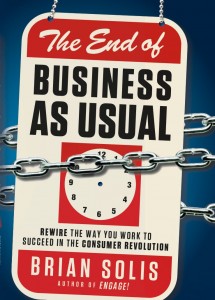 Last week Jeannie Walters and I were discussing Brian Solis’s new book The End of Business As Usual.
Last week Jeannie Walters and I were discussing Brian Solis’s new book The End of Business As Usual.
Because she is a customer experience expert, she was especially interested in what Brian had to say about the connected customer and where business is going because of it.
When I mentioned I was writing a review of the book, she asked if she could join in.
And, because the Pinterest debate between Paul Sutton and I worked so well, we thought we’d do a combined book review.
Jeannie reviews it from the customer experience angle and I review it from the leadership angle.
What Jeannie Says
I expected to skim this book. I admit it. And it’s the kind of book I would describe as “dense.”
I’ve followed Brian for a while now and he never lacks real information backed up with actual research.
This is my favorite book by him so far. My recommendation is to take some time with it. It pays off.
The thing about this book, and the message it conveys throughout, is that it applies to not only marketers or social media types, but to any leader in business. And it’s filled with good examples, insightful graphs, relevant (and surprising) charts and more.
The basic message – companies now must adapt to the consumer revolution or die – is articulated in such a way that I hope it appeals to not just the change-agent marketers but to the entire executive suite.
Of course, from my perspective, this is good news. Customer experience is something I discuss daily, and too often it is defined inside the walls of a company as exactly what they happen to be delivering at that moment. “We are a software company, and as long as we are selling software, we’re delivering a great experience!”
The definition in this book is vast.
Customer experience has little to do with your product and more to do with your customer. Your customer is changing daily. So you better adapt to their behaviors or fall into the digital graveyard of Circuit City and Borders.
The study of how we, each of us, as customers, has changed the game is what makes this so compelling.
After all, nobody told the Millennials to get on the technology bandwagon, they just live there.
We turn to our friends and families for referrals the most, but we do it now through social networks – sometimes, depending on our age and other factors.
The world is not linear anymore.
Brian’s definition of “the connected customer” is the closest I’ve seen to reality.
There are a lot of gems in this book, including how to differentiate the segments of the connected customer population and what steps to take to truly engage at each level with your own customers.
But the best part is the intelligent discussion about customer experience without demonizing companies.
It is a hopeful book, intended to help anyone in business understand they are co-creating the experience with their customers, not creating an “us vs. them” culture.
Go get it! And get some coffee. You’ll be up for some time.
What Gini Says
It’s not a surprise that a book by Brian is … dense. And heady. And highly intelligent. And filled with charts and graphs that support his thinking, as well as research compiled with several companies.
It’s also not a book for those of you already working in a customer-centric business.
What? You’re not already working in a customer-centric business? This book is for you, then.
What I find most interesting are the company examples he uses.
We’re all accustomed to reading about Zappos and what they did with the social web very early on to attract customers who quickly became brand ambassadors.
Nearly 500 Zappos employees use Twitter and they boast millions of followers.
This isn’t a surprise. Most of us already know this story. What is a surprise is the focus on a new type of CEO, one that focuses on designed user or customer experiences.
One that focuses on designed experiences.
Brian describes the E in CEO as standing for “experience.” He says the late Steve Jobs (Apple), Brian Dunn (Best Buy), Michael Dell (Dell), Howard Schultz (Starbucks), and Richard Branson (Virgin) all belong in this elite club of executives because they know how, and have, to create customer-centric businesses.
Businesses that aren’t ruled by the customer, but listen to, and take feedback from, those who buy and refer business.
As the leader of a company (and soon to be a second), this is extremely interesting to me as I learn to pivot our business model, our vision, and our offerings in order to grow.
It’s not a book about social media. It’s not even a book about PR and marketing. It’s a book about changing your business to focus on the customer. Not in a way that will detract from your growth, but in a way that supports and enhances the customer experience.
It’s time to sit up and pay attention. Customers don’t want to talk to the middle man. As was evidenced this week with Susan G. Komen, customers don’t want to be censored.
Customers want to talk to you and it’s time to figure out how to let them…no matter if you sell direct to consumers or not.
Jeannie Walters is a customer experience investigator (a title she has trademarked) and is the owner of 360Connext. She blogs (not often enough, according to Gini) in the same spot. You can follow her on Twitter at @jeanniecw.